NCERT Based Activity: Temperature and its Measurement | Science for Class 6 PDF Download
Activity 7.1: Let us investigate
- Take three large containers and label them A, B, and C (Fig. 7.1).
- Pour warm water in container A, tap water in container B, and ice-cold water in container C.
- Conduct the activity in two parts: prediction and observation.
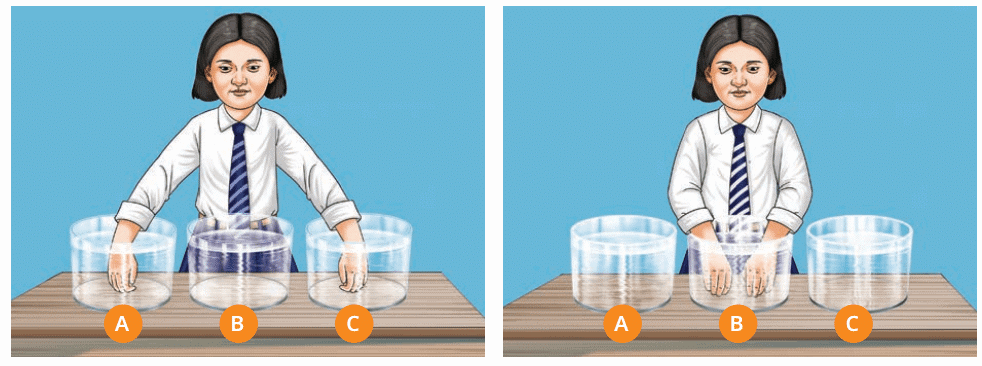 Fig. 7.1: Feeling hotness or coldness of water by dipping hands
Fig. 7.1: Feeling hotness or coldness of water by dipping hands
Predict what you will feel if you:
- Dip your right hand in container A (warm water) and left hand in container C (ice-cold water) for 1-2 minutes.
- Take out both hands from containers A and C and place them simultaneously in container B (tap water).
Write down your predictions:
- What will my right hand feel on dipping it in B?
- What will my left hand feel on dipping it in B?
Ans: Predictions: After dipping the right hand in warm water (A) and the left hand in ice-cold water (C), students may predict:
- Right hand in B (tap water): Will feel cool because tap water is cooler than warm water.
- Left hand in B (tap water): Will feel warm because tap water is warmer than ice-cold water.
Observation:
- Conduct the activity as described.
- Write down your observations.
- Compare whether your observations match your predictions.
- Did your right hand feel that the water in container B is cool, while your left hand felt that the same water is warm? What do you infer from these observations?
Ans: After dipping the right hand in A (warm water, e.g., ~40°C) and the left hand in C (ice-cold water, e.g., ~5°C) for 1-2 minutes, then placing both hands in B (tap water, e.g., ~25°C):
- Right hand: Feels the tap water as cool because it is colder than the warm water it was accustomed to.
- Left hand: Feels the same tap water as warm because it is warmer than the ice-cold water it was accustomed to.
Comparison: Observations likely match predictions, confirming that the same tap water feels different to each hand.
Inference: The sense of touch is not always reliable for judging temperature because it is relative to the temperature the hand was previously exposed to. This shows the need for an objective measurement tool like a thermometer.
Key Learning: The activity demonstrates that subjective sensations of hotness or coldness can be misleading, emphasizing the importance of using thermometers for accurate temperature measurement.
Activity 7.2: Let us measure
Use a digital clinical thermometer to measure your own body temperature and that of some willing friends. Fig.7.2: A digital clinical thermometer
Fig.7.2: A digital clinical thermometer
Follow these steps:
- Wash your hands and the tip of the digital thermometer with soap and water.
- Reset the thermometer by pressing the reset button.
- Place the thermometer under the tongue and close your mouth.
- Wait until the thermometer beeps or flashes a light.
- Take it out and read the temperature on the digital display.
- Record the temperature in Table 7.1.
- Clean the tip of the thermometer with soap and water, and dry it.
- Repeat for your friends. Record observations in Table 7.1.
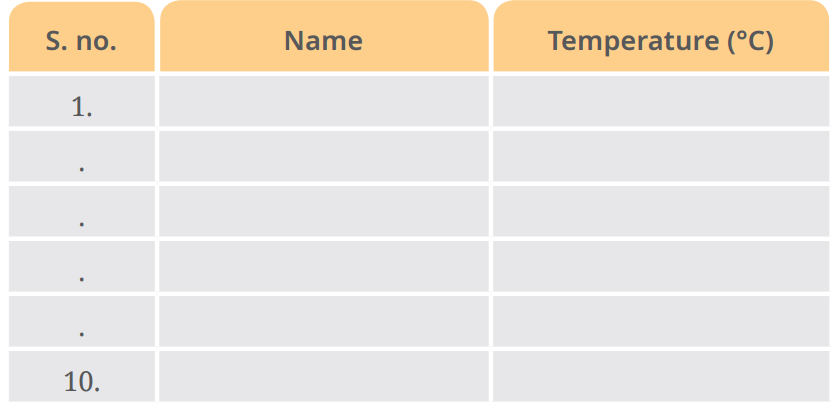
Table 7.1: Body temperatures of 10 persons
Example Table: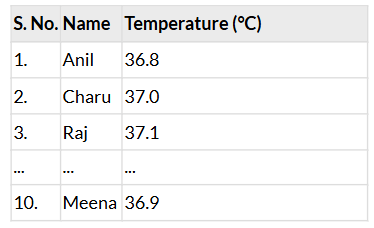
- Not all individuals will have exactly 37.0°C; slight variations are normal.
- Factors influencing variations: Age (children may have slightly higher temperatures, elderly lower), time of day (higher in the evening), or recent activity (exercise increases temperature).
Key Learning: Students learn to use a digital clinical thermometer correctly and understand that normal body temperature varies slightly among individuals and is influenced by external factors. The activity reinforces hygiene practices (cleaning the thermometer) and accurate reading of digital displays.
Activity 7.3: Let us observe
Take a laboratory thermometer and observe it carefully.
Note down the following:
- What is the lowest temperature it can measure?
- What is the highest temperature it can measure?
- So, the range of this thermometer is _______.
- Example: For the thermometer shown in Fig. 7.3a, the range is from -10°C to 110°C.
Ans: For a typical laboratory thermometer (like Fig. 7.3a):
- Lowest temperature: -10°C.
- Highest temperature: 110°C.
- Range: -10°C to 110°C.
- If the school’s thermometer differs, students should note the specific lowest and highest marks on the scale (e.g., 0°C to 100°C for some thermometers).
Example Answer:
- Lowest temperature: -10°C.
- Highest temperature: 110°C.
- Range: -10°C to 110°C.
- Key Learning: Students learn to identify the temperature range of a laboratory thermometer by observing the scale, which is typically broader than that of a clinical thermometer, making it suitable for measuring temperatures of substances like water or ice, but not human body temperature.
Activity 7.4: Let us observe and calculate
Take the same laboratory thermometer used in Activity 7.3 and observe it carefully.
Note down the following:
- How much is the temperature difference indicated between two bigger marks?
- How many divisions (shown by smaller marks) are there between these two bigger marks?
- How much temperature does one small division indicate?
- So, the smallest value that the thermometer can read is _______.
Example: For the thermometer shown in Fig. 7.3b:
- Temperature difference between 0°C and 10°C (or 10°C and 20°C) is 10°C.
- Number of divisions between these marks: 10.
- One small division: 10°C ÷ 10 = 1°C.
- Smallest value the thermometer can read: 1°C.
Ans: For the thermometer in Fig. 7.3b:
- Temperature difference between two bigger marks: 10°C (e.g., 0°C to 10°C).
- Number of divisions: 10.
- Temperature per small division: 10°C ÷ 10 = 1°C.
- Smallest value: 1°C.
- For other thermometers, the smallest value may differ (e.g., 0.5°C if there are 20 divisions between 0°C and 10°C, so 10°C ÷ 20 = 0.5°C).
Example Answer:
- Temperature difference: 10°C.
- Number of divisions: 10.
- One small division: 1°C.
- Smallest value: 1°C.
Key Learning: Students learn to determine the precision of a laboratory thermometer by calculating the value of the smallest division, which indicates how accurately the thermometer can measure temperature. This varies between thermometers, so careful observation is necessary.
Activity 7.5: Let us measure
- Take some warm water in a beaker.
- Dip the laboratory thermometer in the water so that the bulb is immersed but does not touch the bottom or sides of the beaker (Fig. 7.4).
 Fig.7.4: Measuring temperature of warm water
Fig.7.4: Measuring temperature of warm water - Hold the thermometer vertically, ensuring it is not tilted.
- Observe the rise of the liquid column (alcohol or mercury) in the thermometer.
- Wait until the column stops rising and note the temperature while the thermometer is still immersed (do not wait too long, as the water may cool).
- Compare your reading with those of your friends.
- Note: As soon as you take the thermometer out of the water, the liquid column begins to fall, so the temperature must be read while immersed.
Ans: Observations:
- The temperature of warm water might be, e.g., 40°C to 50°C, depending on how warm it is.
- Example reading: 45°C.
- Readings among friends may vary slightly (e.g., 44°C, 46°C) due to differences in water temperature, thermometer precision, or reading accuracy.
Example Answer:
- Temperature measured: 45°C.
- Comparison: Friend 1: 44.5°C, Friend 2: 45.2°C, Friend 3: 44.8°C.
Key Learning:
- Students learn the correct procedure for using a laboratory thermometer: immersing the bulb without touching the beaker, holding it vertically, and reading while immersed to avoid errors due to cooling.
- They observe that the liquid column falls when removed from the water, reinforcing the need to read the temperature in situ.
- Variations in readings highlight the importance of following the correct procedure.
Activity 7.6: Let us compare
- Phiban’s Science teacher arranged an experimental setup to measure the temperature of boiling water.
- The temperature readings taken by Phiban and her classmates in Shillong are given in Table 7.2.
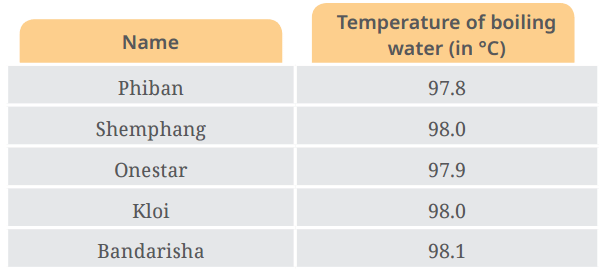 Table 7.2: Temperature of boiling water
Table 7.2: Temperature of boiling water - Compare the temperatures of boiling water recorded by different students.
- Discuss possible reasons for differences in their readings.
Ans:
Comparison: Readings range from 97.8°C to 98.1°C, with a difference of 0.3°C. All readings are below 100°C, the standard boiling point of water at sea level.
Possible Reasons for Differences:
- Incorrect Procedure:
- Thermometer not held vertically or bulb touching the beaker’s bottom/sides, affecting the reading.
- Reading taken after removing the thermometer, allowing the liquid column to fall.
- Eye not level with the liquid column, causing parallax error.
- Environmental Factors:
- Shillong is at a high altitude (e.g., ~1,500 m above sea level), where atmospheric pressure is lower, reducing the boiling point of water to ~98°C (compared to 100°C at sea level).
- Thermometer Variations:
- Slight differences in thermometer calibration or precision (e.g., smallest division of 1°C vs. 0.5°C).
- Experimental Conditions:
- Variations in water purity or heating rate affecting the exact boiling temperature.
Discussion: Students should conclude that small differences are expected due to measurement errors or environmental factors like altitude. The activity emphasizes the importance of following the correct measurement procedure and understanding external influences on boiling point.
Key Learning: Students learn that temperature measurements can vary slightly due to human error, equipment differences, or environmental conditions, and that the boiling point of water depends on atmospheric pressure.
Activity 7.7: Let us analyse
- Read or listen to weather reports for a place for 10 successive days.
- Record the maximum and minimum air temperature for each day in Table 7.3.
- Analyse the data in Table 7.3.
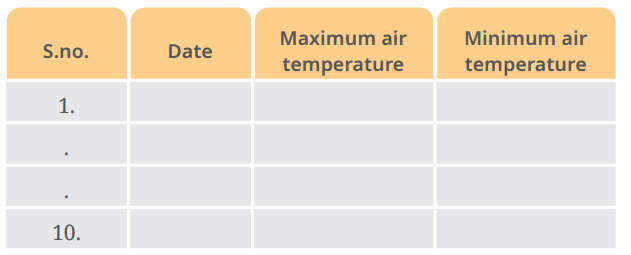
Table 7.3: Maximum and minimum air temperature
Ans: Observations:
- Students collect data from weather reports (e.g., newspapers, TV, internet) for a specific location.
- Example data for a city in May 2025 (hypothetical, as real data depends on the location and time):
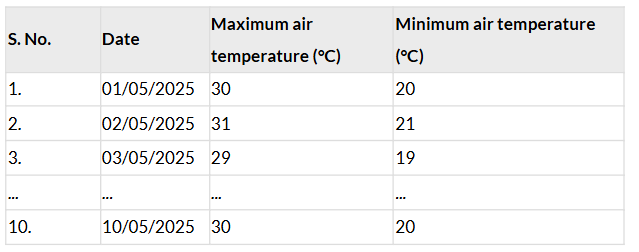
Analysis:
- Maximum temperatures may range from, e.g., 29°C to 32°C, and minimum temperatures from 19°C to 22°C, depending on the season and location.
- Temperatures do not stay constant; they vary daily due to weather factors like cloud cover, humidity, or wind.
- General trend: Temperatures may rise as summer approaches or fall in winter, but daily fluctuations occur.
Q: Does the maximum and minimum temperature stay at the same level during these days?
Ans: No, the maximum and minimum temperatures do not stay at the same level. They vary each day due to weather changes.
Key Learning:
- Students learn that air temperature is a dynamic weather parameter that changes daily and is influenced by multiple factors.
- The activity introduces the concept of weather monitoring and the use of room thermometers or weather station data for tracking temperature trends.
|
86 videos|288 docs|27 tests
|
FAQs on NCERT Based Activity: Temperature and its Measurement - Science for Class 6
| 1. What is temperature and how is it measured? |  |
| 2. Why is temperature important in our daily life? |  |
| 3. What are the different scales used for measuring temperature? |  |
| 4. How does a thermometer work? |  |
| 5. What are some common types of thermometers used? |  |
















